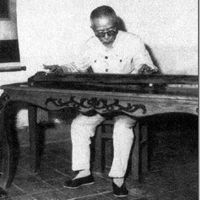Pu Xue Zhai

Mr. Pu Xuezhai has studied literature and art since childhood and is good at calligraphy and painting. He is a famous painter and calligrapher. After the Revolution of 1911, he made a living by painting and calligraphy. As early as 1930, he taught at the Fine Arts Department of Fu Jen Catholic University, serving as a professor and head of the department. And organized the "Songfeng Painting Society" to study the art of Chinese painting and cultivate a large number of talents. He is good at painting landscapes, horses, Molan, etc. Mi Fu and Zhao Mengfu, who studied calligraphy, integrated Mi and Zhao into one, with a unique verve that is rigorous and unrestrained. He is also a guqin player. Soon after the liberation of the People's Republic of China, he participated in the organization of the Beijing Guqin Research Association.
After Xuantong left the palace in the winter of 1924, Puxuezhai founded together with Pu Xinshe (No. Songchao), Pu Yizhai (No. Songlin), Guan Songfang (No. Songfang), Hui Xiaotong (No. Songxi), etc. Songfeng Painting Society, a famous Chinese painting group in modern times. Self-named "Pine Snow". He is the first head of the Songfeng Painting Society, which is one of the main components of the Beijing-Tianjin School of Painting. It has a history of nearly 90 years and has produced Puxuezhai and Puzuo (Songkan). ), Guan Ruizhi (Guan Songfang's direct biography), the three leaders of the painting association.
After liberation, he actively participated in cultural exchange activities at home and abroad. He served as executive director of Beijing Federation of Literary and Art Circles, vice chairman of Beijing Artists Association, vice president of Calligraphy Research Society, honorary painter of Beijing Painting Academy, director of Municipal Music Association and member of Dongcheng District Political Consultative Conference. In 1952, he was hired as a librarian at the Beijing Municipal Research Institute of Literature and History. His various artistic achievements have been highly appraised and appreciated by people at home and abroad.
In the 1950s, the first National Congress of Literary and Artistic Workers was held. Premier Zhou Enlai met Mr. Xue Zhai at the meeting and asked him about his life and work with concern. After the meeting, he personally drove him home by car. In 1957, the Beijing Chinese Painting Academy was established and was hired as an honorary painter. Premier Zhou made important instructions at the inaugural meeting of the Academy of Painting. When taking a group photo with all the participants after the meeting, Premier Zhou stopped beside him and said jokingly, "Let's have a Manchu-Han party!" After the performance, Premier Zhou went to the backstage to thank him for his wonderful performance and congratulated him on the success of the performance. On Pu Lao's 70th birthday, Vice Premier Chen Yi, on behalf of the Party Central Committee and the State Council, invited him to a luncheon at Ziguang Pavilion in Zhongnanhai to congratulate him on his birthday. He moved to Vice Premier Chen and said: "I haven't done much work, and I can't talk about my achievements. I feel very well-deserved for the honor given to me by the leaders." Chairman Zhu De also had many times with him in Beihai Huafang Zhai. Coca Ting studied the art of calligraphy and painting together and took a group photo. After his home was raided during the Cultural Revolution in 1966, he ran away with his daughter on August 30, and his whereabouts are still unknown.
Pu Xue Zhai was established in May 1954 in Beijing Liaison Organization, established the Beijing Guqin Research Association and served as the president. The Association accepts the leadership and funding of the Chinese Music Research and the Chinese Musicians Association, contacts guqin players and music lovers from all over the world, and engages in academic research, performance and teaching of guqin.
Laoba Zhangzhong also specially recorded four recordings of Pu Xue Zhai in CD05: Good Night Intro, Ou Lu Forgetting Machine, Plum Blossom Three Lanes, and Pu'an Mantra.
Similar artist
Involving musical instruments
Involved portfolio
Involved news
Popular artists
- 01 Zhang Xiuyan
- 02 King Hammer
- 03 Deng Jiandong
- 04 A Shicai
- 05 Li Muliang
 渝公网安备 50010702504639号
渝公网安备 50010702504639号